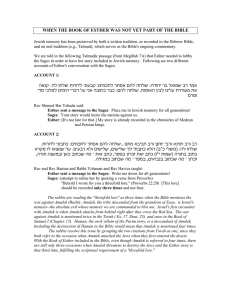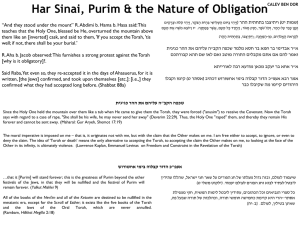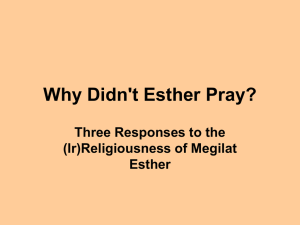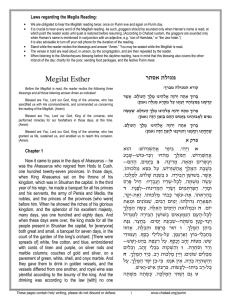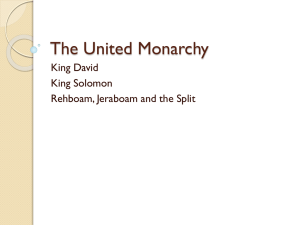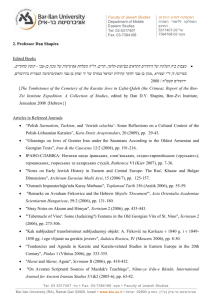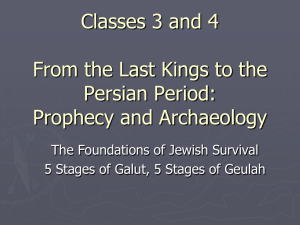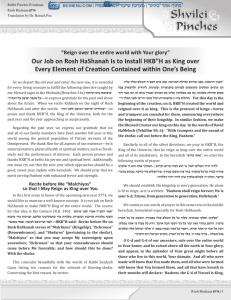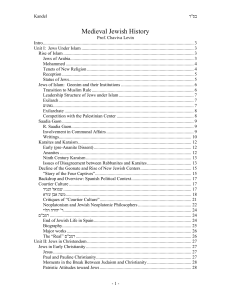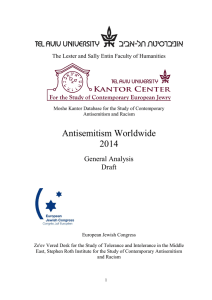The Story of Purim In a Nutshell A summary
advertisement
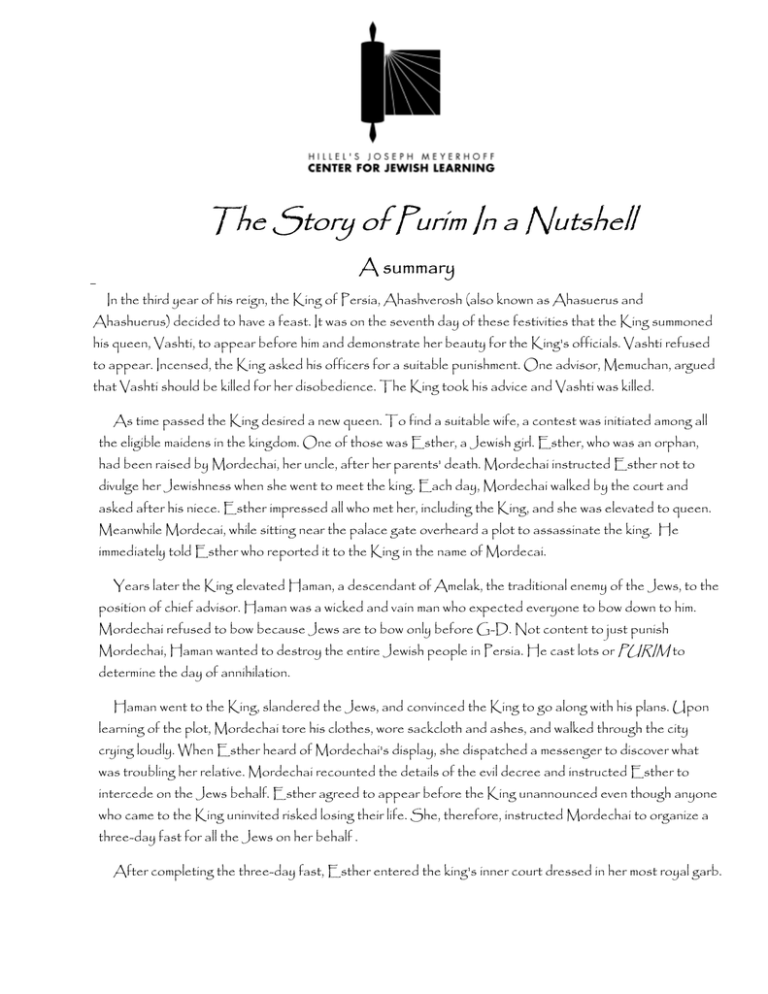
The Story of Purim In a Nutshell A summary In the third year of his reign, the King of Persia, Ahashverosh (also known as Ahasuerus and Ahashuerus) decided to have a feast. It was on the seventh day of these festivities that the King summoned his queen, Vashti, to appear before him and demonstrate her beauty for the King's officials. Vashti refused to appear. Incensed, the King asked his officers for a suitable punishment. One advisor, Memuchan, argued that Vashti should be killed for her disobedience. The King took his advice and Vashti was killed. As time passed the King desired a new queen. To find a suitable wife, a contest was initiated among all the eligible maidens in the kingdom. One of those was Esther, a Jewish girl. Esther, who was an orphan, had been raised by Mordechai, her uncle, after her parents' death. Mordechai instructed Esther not to divulge her Jewishness when she went to meet the king. Each day, Mordechai walked by the court and asked after his niece. Esther impressed all who met her, including the King, and she was elevated to queen. Meanwhile Mordecai, while sitting near the palace gate overheard a plot to assassinate the king. He immediately told Esther who reported it to the King in the name of Mordecai. Years later the King elevated Haman, a descendant of Amelak, the traditional enemy of the Jews, to the position of chief advisor. Haman was a wicked and vain man who expected everyone to bow down to him. Mordechai refused to bow because Jews are to bow only before G-D. Not content to just punish Mordechai, Haman wanted to destroy the entire Jewish people in Persia. He cast lots or PURIM to determine the day of annihilation. Haman went to the King, slandered the Jews, and convinced the King to go along with his plans. Upon learning of the plot, Mordechai tore his clothes, wore sackcloth and ashes, and walked through the city crying loudly. When Esther heard of Mordechai's display, she dispatched a messenger to discover what was troubling her relative. Mordechai recounted the details of the evil decree and instructed Esther to intercede on the Jews behalf. Esther agreed to appear before the King unannounced even though anyone who came to the King uninvited risked losing their life. She, therefore, instructed Mordechai to organize a three-day fast for all the Jews on her behalf . After completing the three-day fast, Esther entered the king's inner court dressed in her most royal garb. The King granted her an audience promising her that virtually anything she would ask would be granted. Esther replied that she wished to invite the King and Haman to a banquet on that day. After the feast Esther asked the King and Haman to return for another banquet the following night. Haman left the banquet consumed with self- importance and pride, but these feelings were turned to anger when he saw Mordechai sitting at the gate of the King’s palace and paying Haman no mind. Haman went home fretting over the impudent Mordecai. His wife, Zeresh, advised him to construct a gallows and ask the King that Mordecai be hanged. Haman joyously acted upon the suggestion. That night, the King discovered that Mordechai had never been rewarded for saving him from the assassination plot of two servants. When Haman appeared in the court, the King decided that his trusted servant should determine Mordechai's compensation. Haman, intending to obtain the King's permission to hang Mordechai, unwittingly answered the King's questions. The King asked Haman"What should be done for the man the King wishes to reward?" Haman, believing that Ahashverosh intended to reward him, replied that the honoree should be dressed in royal clothing, ride upon a royal horse. And be led through the city streets by an official proclaiming "This is what is done to the man the King wishes to honor". Ahashverosh agreed and instructed Haman to do what he had declared for Mordecai. Crestfallen, Haman followed the King's orders and dressed Mordecai in royal clothing and Haman led Mordecai around the city on a fine horse. At Esther's second banquet Haman's downfall continued. Esther revealed Haman's villainous plot and the fact that she was Jewish. She asked the King to "grant me my soul and my people." Ahashverosh consumed with anger ordered that Haman be hanged on the gallows intended for Mordechai. The King elevated Mordechai to a position of great influence and allowed him to issue edicts permitting the Jews to fight their enemies. On the thirteenth and fourteenth of Adar the Jews won tremendous victories and were saved from the threat of total annihilation. Ever since, Jews have observed Purim. The day before Purim is a day of fasting, in memory of Esther's fast. The fast is then followed by two days of dancing, merrymaking, feasting and gladness where Jews celebrate by telling this story, drinking, giving gifts to the poor, and food to each other. 2 There are four requirements for celebrating Purim: 1. We hear the story of Esther as recounted in the Bible. 2. We have a festive meal with more wine than usual. 3. We deliver two different kinds of food to friends and neighbors. 4. We give gifts to the poor. What does this say about the way Jews “party”? From the Book of Esther oh¦r&p§x j¿-k§J°H³u v5K·¥t¨v oh¼¦r&c§S©v?,¤t hº-f¢S§r¨n c«ÉTIf°H³uJf oh¼KcIr§E©v JIºr¯u§J©j£t Q5kɤN©v ¿,Ibh¦s§n?k&fIC ¿r¤J£t oh½¦sUv±H©v?k&F?k¤t ¿r«¨a&g vÊ&g&C§r©t oIÉh ,¥tÆ oh«½¦a«g ,IÉh§vKk ¸o¤vh^k_g ¾o¯H©eIkJtf :ohc¦eIj§r¨v±u oh½¦n²H-FJcf :vc²b¨J±u v¼²b¨J?k&fIC I·C r«¼¨a&g v˨f¦n£j?oIh ,Á¥t±u rº¨s£t J¤s«ÉjIk ¿iId²H¦n oʤv&k Q¿-P§v®b Ïr¤J£t J¤s«½j©v±u oº¤vh^c±hIÉt¥n ¿oh¦sUv±H©v oʤv&c Uj¿²b?r¤J£t vº¨j§n«¦a±u vɤT§J¦n ¿h¥n±h o½¨,It ,I«Éa_gc-k cI·y oIÉhIk k5c¼¥t¥nU vº¨j§n«¦aIk ohc°bIhIc¤tc&k ,I¼b¨T©nU Uvº^g¥rIk Jhɦt ¿,Ib¨n ©jIÊk§J¦nU “And Mordechai wrote these words and sent messages to the Jews in all the provinces of King Ahaseueras both near and far. That they would take upon themselves to observe the fourteenth of the Month of Adar and the fifteenth of that month each and every year. Like the days when the Jews rested from their enemies and the month was transformed from misery to joy, from mourning to celebration, to make them into days of merrymaking and feasting, of sending portions of food to friends and neighbors, and gifts to the poor.” 3 A Purim Conversation The Rabbis of the Talmud see the name Esther as derived from the Hebrew word Hester which means hidden. God is hidden by virtue of the fact that God’s name does not appear once in the whole book. Mordecai instructs Esther to hide her identity as a Jew until she is called upon to save her people by risking her life and revealing herself. When the dominant society isn’t welcoming, it often is easier to “hide”. Mordecai puts Esther in this uncomfortable position before there is any indication that the Jews are in jeopardy. • Why would he do this? Can we imagine ourselves doing the same thing? Have we ever done something similar in our own lives? • In Persian, Esther means “star”, but in Hebrew, as we have mentioned, the Hebrew root could be “hidden”. If Esther would ultimately reveal herself, did she have to hide at all? • Has “hiding, or passing” ever been beneficial for us? What was its cost? Traditionally, the Festival of Purim is called the holiday of hidden miracles. Isn’t that a contradiction in terms? • What constitutes a hidden miracle? Define it. • Why is it important to have a book in Hebrew Scriptures that acknowledges hidden miracles? • Describe a hidden miracle in your life. • What do all hidden miracles have in common, including the ones in the Book of Esther? 4 CREATIVE HOLIDAY PROGRAM IDEAS GENERATED AT THE 2001 SCHUSTERMAN HILLEL INTERNATIONAL PROFESSIONAL STAFF CONFERENCE PURIM A Purim Knight WHO: General population, Greek students. WHAT: Have a Megillah reading and Purim feast/celebration with a Medieval theme. Students dress up as knights, ladies, jesters, etc. As they tell the story of Purim, they have a medieval dinner with goblets, plates, etc. Medieval festivities such as jousting and juggling will also take place. Invite people with scroll invitations. HOW: Jewish learning will take place in a couple of ways. There will be a discussion over dinner of how Purim was celebrated in different time period (in terms of celebration and food). There will be an emcee for the night—perferably the rabbi or Jewish educator as court jester—who will narrate the Megillah reading and add Jewish content. In addition, there could be a reenactment of the Raba and Rebbe Zera sacrifice. WHEN: First night of Purim. WHERE: At Hillel if there is a big space; if not, reserve a room on campus. Purim Party WHO: General population. WHAT: Canned food drive and Megillah reading/party. HOW: Before the party, have someone dress up as town crier and give out invitations. Have a canned food drive or a clothing drive in conjunction with the party. For every item you donate (either before the party or at the party), you get a lottery ticket. The lottery tickets explain the term ‘purim’ and give some background information about the holiday. At the party/Megillah reading, have a drawing from the lottery tickets for an exciting prize. If you have a clothing drive, people can dress up in the donated clothes when they arrive. At the end of the evening, the wearers can either take home the clothes or give them back to be donated to a shelter. An alternative costume option is to have everyone come dressed up as their secret identity (lawyer, astronaut, superhero, etc). WHEN: First night of Purim WHERE: ----. Masquerade Marathon WHO: Tzedek students, general population, and can be expanded to whole campus. WHAT: A 48-hour masquerade dance marathon to raise money for a homeless shelter. Shifts can be made up of the different communities invited – freshmen, Greeks, student 5 clubs, faculty, staff. Sponsors from big corporations can sponsor each dancer for the amount of hours they dance. HOW: Pieces of the Megillah hung on the walls around the room. WHEN: During the two days of Purim. WHERE: Big Area - either the gym or the cafeteria. The Whole Megillah WHO: General population - Greek students, women, non-engaged students, engaged students, etc. WHAT: For engaged students to hear the Megillah; for non-engaged students to see the Megillah. HOW: A local rabbi will read the Megillah. Greek students will act out the Megillah while it is read. There will be a summary between chapters. For Mishloach Manot, there will be opportunities to sell/buy two hamentashen for a friend. To advertise for the event, 1)have a canned food drive the whole month 2)have a countdown sign on the quad 3)place ads in the paper 4)distribute fliers 5)ask engage students to come in costume At the Megillah reading, you can advertise for other events – a lunch feast to follow at Hillel, or a party to happen that evening. WHEN: Lunchtime (noon-1 p.m.), the busiest time. WHERE: Campus quad/central location 6 What Mitzvot would Esther ask us to keep? On Ritualizing Purim The following verses in the Megilla (Book of Esther) record how the festival was celebrated in Esther's time and in succeeding generations. List the rituals that you learn from these verses and detail how they would be observed. Mordecai recorded these events. And he sent dispatches to all the Jews throughout the provinces of King Ahasueras , near and far, charging them to observe the fourteenth and fifteenth days of Adar1, every year--the same days on which the Jews enjoyed relief from their foes and the same month which had been transformed for them from one of grief and mourning to one of festive joy. They were to observe them as days of feasting and merrymaking, and as an occasion for sending a package of gifts from one friend to another, and gifts to poor people. The Jews accordingly assumed as an obligation that which they had begun to practice and which Mordecai prescribed for them. (Esther 9:20-23) ... the Jews undertook and irrevocably obligated themselves and their descendants, and all who might join them, to observe these two days in the manner prescribed and at the proper time each year. Consequently, these days are recalled and observed in every generation: By every family, every province, and every city. And these days of Purim shall never cease among the Jews, and the memory of them shall never perish among their descendants. (Esther 9:27-28) How to observe Purim according to the rabbis of the Talmud: 1. FEASTING AND MERRYMAKING Talmud Megilla 7a Rava said: "A person is obliged to get spiced [spiced wine, vermouth] on Purim until he can no longer tell the difference between 'Cursed be Haman' and 'Blessed be Mordecai.'" Raba and Rebbe Zera were having their Purim feast together and they became intoxicated. Raba rose and ritually slaughtered Rebbe Zera. The next day he prayed for mercy and 1 In the provinces of Persia the fighting ceased on the thirteenth of Adar and the Jews celebrated on the fourteenth. In the walled city of Shushan, where the action takes place, the fighting continued through the fourteenth and the Jews celebrated on the fifteenth of Adar. Today, Jews in the diaspora and unwalled cities in Israel celebrate Purim on the fourteenth while in Jerusalem, a walled city, they celebrate Purim on the fifteenth of Adar. 7 Rebbe Zera was revived. The next year Raba invited Rebbe Zera for another Purim feast. Rebbe Zera said: "One cannot rely on miracles every year." Rava also said: "A Purim feast that was celebrated at night does not fulfill one's obligation." What's the reason? It is written, "Days of feasting and merrymaking." (Esther 9:22) YOUR TALMUD NAVIGATOR After Rava states that one is obliged to get drunk on Purim, does the story of Raba and Rebbe Zera support this view or contradict it? Give reasons. (Note: Raba and Rava were two different rabbis) 2. GIFTS TO POOR PEOPLE & A PACKAGE OF PORTIONS TO A FRIEND Rabbi Yosef taught: How does one fulfill the obligation of "sending a package of gifts from one friend to another"? One must send two different portions to at least one friend. And "gifts to poor people"? One must give two gifts to two people. YOUR NAVIGATOR AGAIN Looking closely at the passage from the Megilla on the previous page, what textual clue can you find for why Rav Yosef requires "two different portions" for sending gifts to a friend and "two people" to be recipients of gifts to the poor? Why do you think that we are commanded to give gifts both to a friend and to the poor? What is the difference between the two acts? 3. READING THE MEGILLA Rabbi Yehoshua Ben Levy said: One is obliged to read the megilla at night and repeat it during the day. These 1) 2) 3) 4) 5) 6) are four major themes being addressed by the Megilla: Partying and excessive drinking Gifts to Friends Exploitation of and salvation by women Gifts to the poor Remembering the event Hiding and Passing as someone you’re not (Masks, Costumes, Cross Dressing etc…) What programs prior to and during Purim could you create involving one or more of these themes? How would you build the program from some of the texts that you have studied above? How would you present what you have learned to the participants in the program? 8 What media would you use to seamlessly integrate the Jewish content with the actual activity? WHEN THE BOOK OF ESTHER WAS NOT YET PART OF THE BIBLE Jewish memory has been preserved by both a written tradition, as recorded in the Hebrew Bible, and an oral tradition (e.g., Talmud), which serves as the Bible's ongoing commentary. We are told in the following Talmudic passage (from Megillah 7A) that Esther needed to lobby the Sages in order to have her story included in Jewish memory. Following are two different accounts of Esther's conversation with the Sages: ACCOUNT 1: קנאה את:ת שלחו לה ִ קבעוני לדורו: שלחה להם אסתר לחכמים:אמר רב שמואל בר יהודה כבר כתובה אני על דברי הימים למלכי מדי ופרס: שלחה להם.מעוררת עלינו לבין האומות Rav Shmuel Bar Yehuda said: Esther sent a message to the Sages: Place me in Jewish memory for all generations! Sages: Your story would incite the nations against us. Esther: [It's too late for that.] My story is already recorded in the chronicles of Medean and Persian kings. ACCOUNT 2: : שלחו לה. כתבוני לדורות:שלחה להם אסתר לחכמים...רב ורב חנינא ורבי יוחנן ורב חביבא מתנו עד שמצאו לו מקרא כתוב בתורה. שלישים ולא רבעים,)משלי כ"ב( הלא כתבתי לך שלישים זכרון ־ מה שכתוב, כתב זאת ־ מה שכתוב כאן ובמשנה תורה,)שמות י"ז( כתב זאת זכרון בספר . בספר ־ מה שכתוב במגילה,בנביאים Rav and Rav Hanina and Rabbi Yohanan and Rav Haviva taught: Esther sent a message to the Sages: Write me down for all generations! Sages: (attempt to refute her by quoting a verse from Proverbs) "Behold I wrote for you a threefold lore." (Proverbs 22:20) [This lore] should be recorded only three times and not four. The rabbis are reading the "threefold lore" as three times when the Bible mentions the war against Amalek (Rashi). Amalek, the tribe descended from the grandson of Esau, is Israel's nemesis--the absolute evil whose memory we are commanded to blot out. Israel's first encounter with Amalek is when Amalek attacks from behind right after they cross the Red Sea. The war against Amalek is mentioned twice in the Torah ( Ex. 17. Deut. 25) and once in the Book of Samuel I (Chapter 15). Haman, the arch villain of the Purim story, is a descendant of Amalek. Including the destruction of Haman in the Bible would mean that Amalek is mentioned four times. 9 The rabbis resolve this issue by grouping the two citations from Torah as one, since they both refer to the occasion when Amalek attacked the Jews when they first entered the desert. With the Book of Esther included in the Bible, even though Amalek is referred to four times, there are still only three occasions when Amalek threatens to destroy the Jews and the Esther story is that third time, fulfilling the scriptural requirement of a "threefold lore." THE TALMUD NAVIGATOR 1) What are Sages' concerns with respect to including the Book of Esther in the Bible? What do you think would be Esther's reasons for being included? 2) Compare the two accounts of Esther's conversation with the Sages. What is the difference between her asking to be remembered and her asking to be "written down"? Purim is the only Holy day in which the protagonist must lobby for inclusion in Jewish memory. Our next passage searches for clues within the Book of Esther that reveal that Esther is indeed imbued with the "holy spirit", a requirement to qualify as a Holy book. רבי. שנאמר )אסתר ו'( ויאמר המן בלבו, אסתר ברוח הקודש נאמרה: רבי אליעזר אומר,תניא . שנאמר )אסתר ב'( ותהי אסתר נשאת חן בעיני כל ראיה, אסתר ברוח הקודש נאמרה:עקיבא אומר רבי יוסי בן. שנאמר )אסתר ב'( ויודע הדבר למרדכי, אסתר ברוח הקודש נאמרה:רבי מאיר אומר אמר. שנאמר )אסתר ט'( ובבזה לא שלחו את ידם, אסתר ברוח הקודש נאמרה:דורמסקית אומר שנאמר קימו וקבלו ־ קימו למעלה מה, אי הואי התם הוה אמינא מלתא דעדיפא מכולהו:שמואל דרבי אליעזר ־. לבר מדשמואל דלית ליה פירכא, לכולהו אית להו פירכא: אמר רבא.שקיבלו למטה והאי כי קא מפיש טובא ואמר ־ אדעתיה דנפשיה, דלא הוה איניש דחשיב למלכא כוותיה,סברא הוא והא. מלמד שכל אחד ואחד נדמתה לו כאומתו: דאמר, דרבי עקיבא ־ דלמא כרבי אלעזר.קאמר והא דרבי יוסי בן. בגתן ותרש שני טרשיים היו: דאמר,דרבי מאיר ־ דלמא כרבי חייא בר אבא : היינו דאמרי אינשי: אמר רבינא. דשמואל ודאי לית ליה פירכא.דורמסקית ־ דלמא פריסתקי שדור טבא חדא פלפלתא חריפתא ממלי צני קרי (note: structural liberties have been taken in translation) Rabbi Eliezer: Esther was uttered through the Holy Spirit! As we see [from the Megilla] "And Haman thought to himself..." (Esther 6:6) The Talmud: That proof can be challenged! One can determine what Haman was thinking since it was well known that the king favored him above all others in the kingdom. Rabbi Akiba: Esther was uttered through with the Holy Spirit! As we see, "And Esther was favored by all who saw her." (Esther 2:15) The Talmud: Maybe this verse could be understood the way Rabbi Eliezer did, "That everyone viewed her as if she was one of their own people." 10 Rabbi Meir: Esther was uttered through the Holy Spirit! As we see, "Mordecai became aware of the plot [to dispose of Ahasuerus]" (Ibid:22) The Talmud: Maybe this verse could be understood to mean that Mordecai did not just become aware , but that the plotters Bigtan and Teresh were from Tarsis and plotted in their native tongue thinking that Mordecai would not understand them... Shmuel: If I had been included in that conversation (Shmuel is from a later generation.) I would have proved [that Esther was said through the "Holy Spirit] in a manner that would have been impossible to challenge. As we see: "They affirmed and they received." (Ibid 9:27) My interpretation is: They affirmed above (in the heavens) what had been received below (on earth). The Talmud: Shmuel's prooftext is indeed impossible to challenge! As Ravina says, "Like the folks say, one hot pepper is better than a pile of cold pumpkins!" THE TALMUD NAVIGATOR 1. How does each of the rabbis understand the Holy Spirit? (First figure out how each rabbi was using his verse as proof) 2. How is Shmuel's interpretation different from those of the other rabbis? Why is his interpretation considered unassailable? 11
